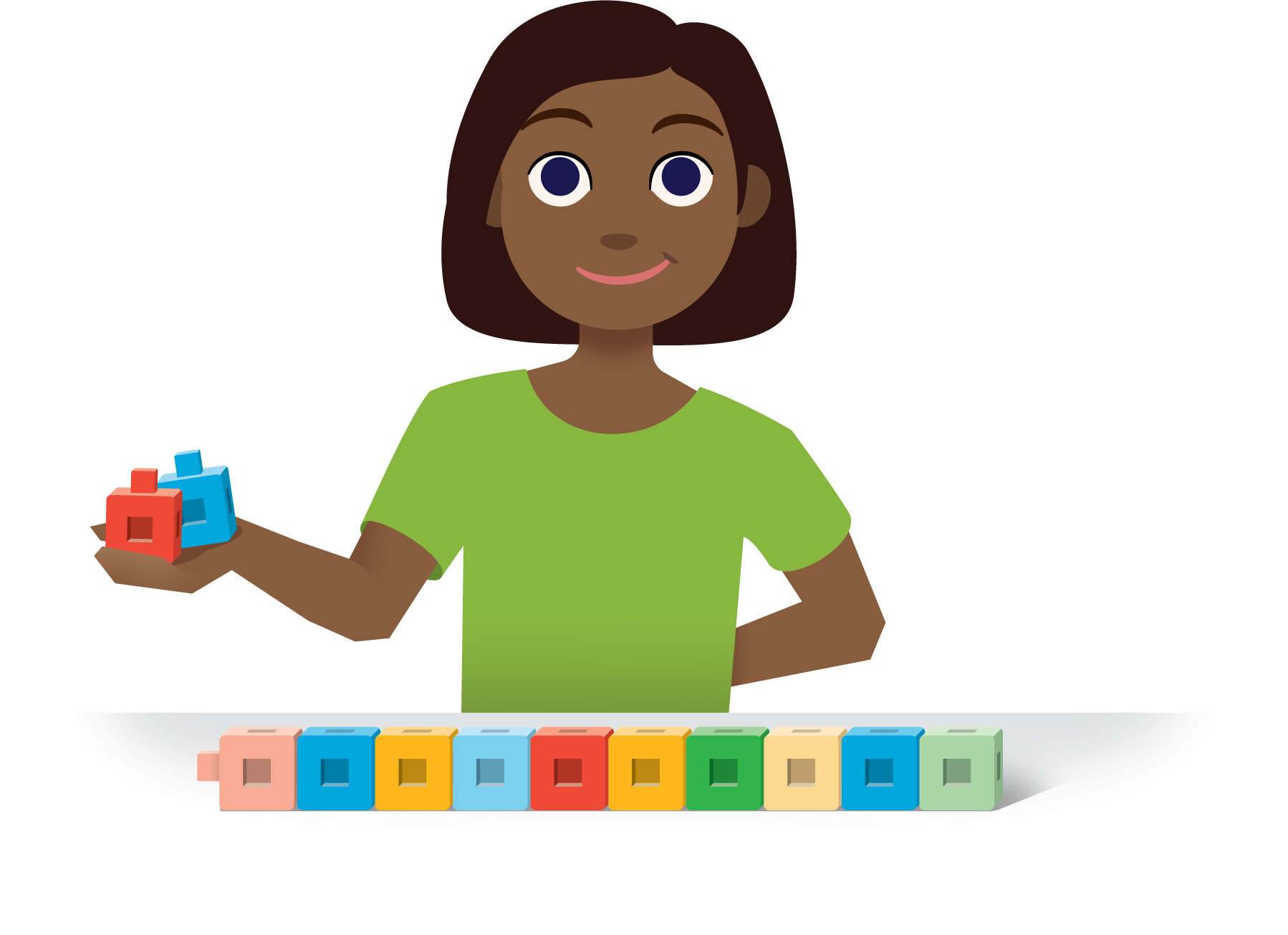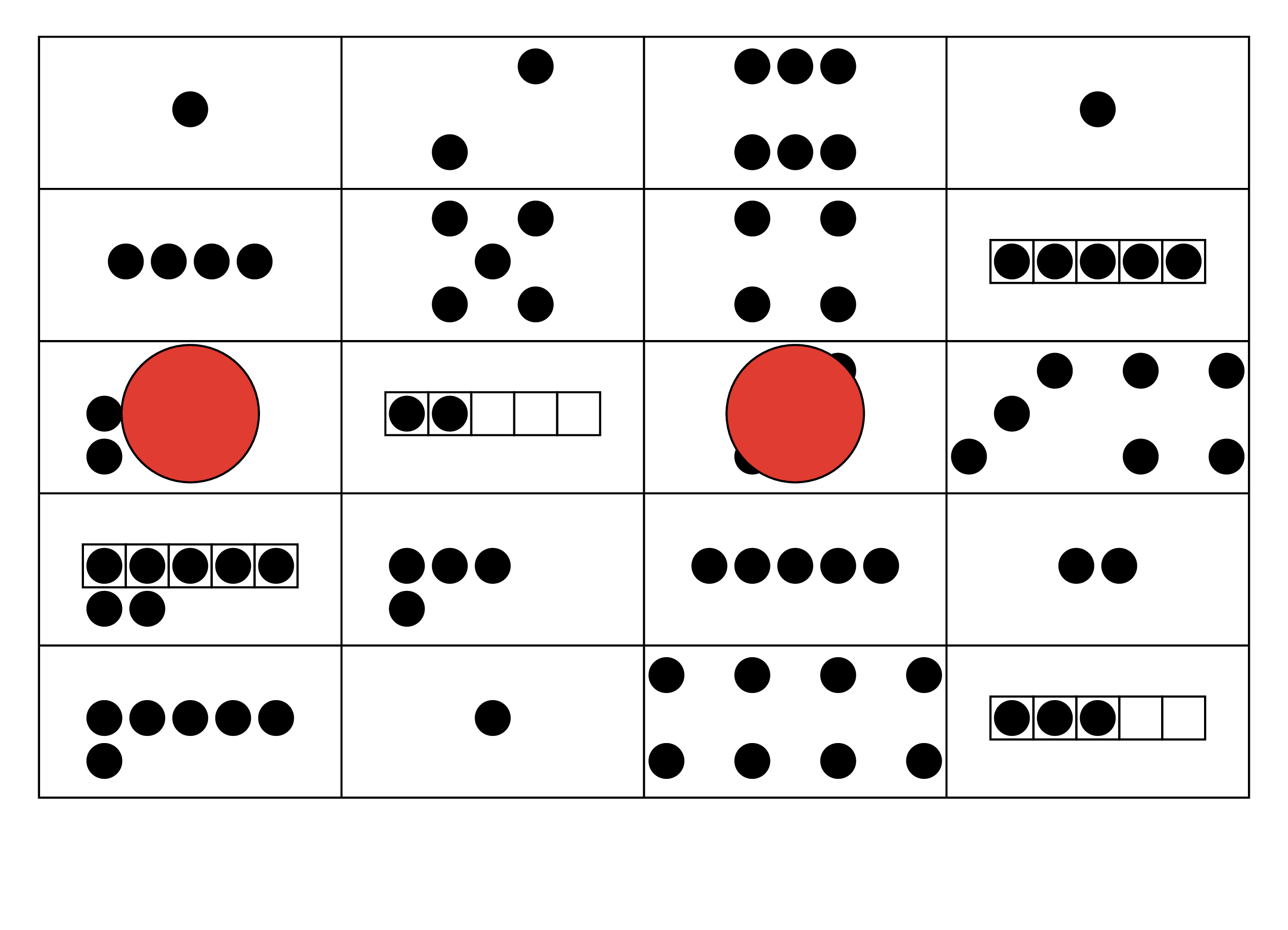Lesson 9
All of the Story Problems
Warm-up: Choral Count: Count to 70 and Count On (10 minutes)
Narrative
Launch
- “Let’s count to 70.”
- Count to 70 1–2 times as a class.
Activity
- “Now, start at the number 7 and count to 30.”
- Count on from 7 to 30.
- Repeat 3–4 times starting with other numbers within 10.
Student Response
For access, consult one of our IM Certified Partners.
Activity Synthesis
- “When I say a number, tell your partner what number comes next when we count.”
- “What numbers come after 11 when we count?”
- 30 seconds: partner discussion
- Repeat 3–4 times with numbers 1–20.
Activity 1: All the Story Problems (15 minutes)
Narrative
The purpose of this activity is for students to solve a Take From, Result Unknown and a Put Together/Take Apart, Both Addends Unknown story problem. In the activity synthesis, students match representations to story problems (MP2).
Advances: Representing, Conversing
Required Materials
Materials to Gather
Launch
- Groups of 2
- Give students access to connecting cubes or two-color counters.
- Read the first task statement.
- “Tell your partner what happened in the story.”
- 30 seconds: quiet think time
- 1 minute: partner discussion
- “What are we trying to figure out?” (How many tomatoes are still in the garden?)
- 30 seconds: quiet think time
- 1 minute: partner discussion
- “Show your thinking using drawings, numbers, words, or objects.”
Activity
- 2 minutes: independent work time
- 2 minutes: partner discussion
- “Write an expression to show what happened to the tomatoes in the story.”
- 1 minute: independent work time
- Repeat the steps with the second story problem.
- Identify examples of student work for each problem to share in the activity and lesson syntheses.
Student Facing
-
Mai grew 7 tomatoes in her garden.
She picked 5 of the tomatoes to make salsa.
How many tomatoes are still in the garden?
Expression: ________________________________

-
There are 9 tomatoes in Mai’s garden.
Some of the tomatoes are yellow.
The rest of the tomatoes are red.
How many of the tomatoes are yellow?
Then how many of the tomatoes are red?
Expression: ________________________________
Student Response
For access, consult one of our IM Certified Partners.
Activity Synthesis
- Invite previously selected students to display their work side-by-side for all to see (one for each problem).
- Reread each story problem.
- “Which drawing goes with each story problem?”
Activity 2: Make and Match Story Problems (15 minutes)
Narrative
The purpose of this activity is for students to create an addition or subtraction story problem with the same context as the story problems from the previous activity. It is likely that students will write Add To, Result Unknown and Take From, Result Unknown story problems. If possible, share a variety of problem types in the activity synthesis.
Supports accessibility for: Memory; Organization
Required Materials
Materials to Gather
Launch
- Groups of 2
- Give students access to connecting cubes or two-color counters.
- “In the last activity we heard two different story problems about tomatoes in a garden. What happened in the story problems?”
- 30 seconds: quiet think time
- Share responses.
- “You are going to think of a different story problem about fruits or vegetables in a garden. Remember that your story problem should have a question at the end. You can write words or draw pictures to help you remember the story problem that you create.”
- 3 minutes: independent work time
Activity
- “Tell your partner your story problem.”
- 1 minute: partner discussion
- “Solve the story problem your partner told you. Show your thinking using objects, drawings, numbers, or words.”
- 3 minutes: partner work time
- “Write an expression to show the story problem you solved.”
- 1 minute: independent work time
Student Facing
Record your story problem.
Solve the story problem your partner told you.
Show your thinking using objects, drawings, numbers, or words.
Expression: ___________________________________
Student Response
For access, consult one of our IM Certified Partners.
Activity Synthesis
- Invite students to share their story problems. Represent each story problem with an equation.
Activity 3: Centers: Choice Time (15 minutes)
Narrative
The purpose of this activity is for students to choose from activities that offer practice composing, decomposing, adding, and subtracting numbers.
Students choose from any stage of previously introduced centers.
- What’s Behind My Back?
- 5-frames
- Make or Break Apart Numbers
- Math Stories
Required Materials
Materials to Gather
Required Preparation
- Gather materials from:
- What’s Behind My Back, Stage 1
- 5-frames, Stages 1 and 2
- Make or Break Apart Numbers, Stage 1
- Math Stories, Stages 1–3
Launch
- “Today we are going to choose from centers we have already learned.”
- Display the center choices in the student book.
- “Think about what you would like to do.”
Activity
- Invite students to work at the center of their choice.
- 10 minutes: center work time
Student Facing
Choose a center.
What’s Behind My Back?

5-frames

Make or Break Apart Numbers

Math Stories

Activity Synthesis
- “What was your favorite center to play? Why was it your favorite?”
Lesson Synthesis
Lesson Synthesis
“Today we solved many different story problems about tomatoes in a garden.”
Read the story problems from the first activity and display examples of student work for each story problem.
- Mai grew 7 tomatoes in her garden.
She picked 5 of the tomatoes to make salsa.
How many tomatoes are still in the garden? - There are 9 tomatoes in Mai’s garden.
Some of the tomatoes are yellow.
The rest of the tomatoes are red.
How many of the tomatoes are yellow?
Then how many of the tomatoes are red?
“Why did we all get the same answer to the first story problem? Why did we get different answers for the second story problem?” (In the first story problem, we know she had 7 tomatoes and picked 5 of them, so the answer is 2. In the second story problem, there are different answers because some of the tomatoes are red and some are green.)
Cool-down: Unit 5, Section B Checkpoint (0 minutes)
Cool-Down
For access, consult one of our IM Certified Partners.
Student Section Summary
Student Facing
In this section, we solved story problems with more than one solution.
Han squeezed 9 pieces of fruit to make juice.
Some of the fruits were satsumas.
The rest of the fruits were grapefruits.
How many of the fruits were satsumas?
Then how many of the fruits were grapefruits?
We used objects and drawings to solve story problems.


